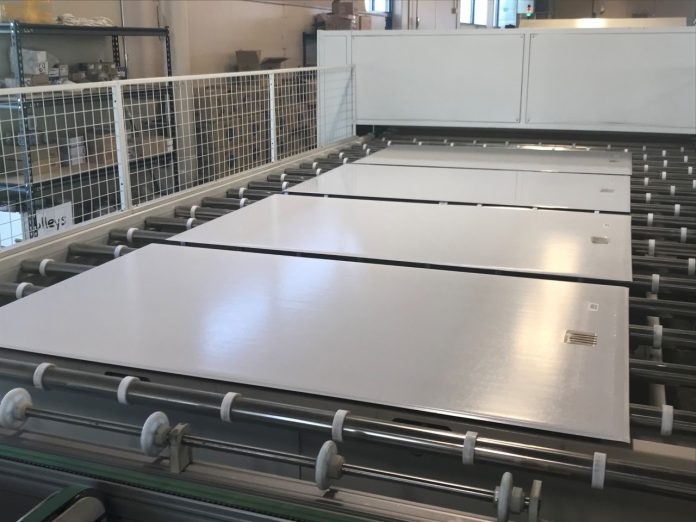US backsheet manufacturer Tomark-Worthen LLC has used continuous co-extrusion processing to develop a new polyamide-based solar module backsheet. It says the product is cost-efficient and highly weather-resistant.
The development of the PhotoMark Reflections 205-3 backsheet was supported by the U.S. Department of Energy’s Office of Energy Efficiency and Renewable Energy (EERE) under the SunShot initiative. The company began working on the product in 2017 and delivered the final results of the project – which is aimed at facilitating the development of a backsheet manufacturing industry in the United States – at the end of April.
“We worked closely with the National Renewable Energy Laboratory, the U.S. Army team at Natick (Massachusetts), the University of Massachusetts at Lowell, and with TÜV, RETEC, UL, Intertek, Fraunhofer and other testing organizations to fully characterize the new product,” the president of Tomark-Worthen, David Santoleri, told pv magazine.
Polyamide properties
It is now producing the backsheet at its facility in Nashua, New Hampshire, with the capacity to crank out 5,700,000 square meters of backsheet per year. The product is available in white and white/black versions and weighs in at 236 g/m², with a thickness of 205 micrometers. It is manufactured without poly-ethylene-terephthalate (PET) or fluoropolymers, and no interlayer adhesive.
The backsheet is based on a novel polyamide-ionomer alloy developed by U.S. chemicals producer DuPont that is available exclusively to Tomark-Worthen for solar applications. The material is said to have properties that are far superior than the polyamide used in the construction sector and other polyamide-based backsheets, or so-called AAA backsheets.
“Early on, the Tomark-Worthen team partnered with DuPont’s packaging and industrial polymers business, now part of Dow, to develop the polyamide-ionomer alloy more fully,” Santoleri said. “This partnership enabled us to create a film that has a relative temperature index of 125 C, excellent UV stability and high performance in both damp heat and thermal cycling.”
The alloy, as well as the other materials in the backsheet construction, are stabilized with a UV/anti-oxidant package that slows down the damaging effects of ultraviolet radiation, according to the manufacturer. “We had to prove that our product worked well and did not fail in the same manner as AAA,” Santoleri explained. “Knowing the failures of the AAA backsheet, it was important for us to evaluate the performance of our backsheet against this material in a test that is accepted by the industry and is known to recreate these failures.”
The National Renewable Energy Laboratory (NREL) conducted Combined Accelerated Stress Testing (CAST) on mini-modules made with the backsheets, along with other co-extruded backsheets used in the industry as controls. “Testing at NREL indicated that PhotoMark Reflections backsheet significantly outperformed both AAA and polyvinylidene fluoride (PVDF)-based backsheets under CAST conditions,” Santoleri said.
Co-extrusion process
The co-extrusion process is an industrial technique that offers a distinct advantage. Once multiple plastic materials are combined, the results can yield properties that are different from those of a single material.
Unlike lamination used for traditional solar module backsheets, co-extrusion enables the production of multilayer backsheets without the use of adhesives, while allowing the manufacturer to eliminate volatile organic compounds in the production process and recycle backsheet trimback into the manufacturing process.
“Major advantages of our backsheet over laminated backsheet includes interlayer bond strength, encapsulant bond and high relative thermal index,” Santoleri said. “Current limitations of the technology include a slightly higher moisture transmission rate and pricing that is still higher than the lowest cost PET-based backsheets in the market.”
Cost considerations
According to Santoleri, the backsheets can be produced at a cost that is acceptable to many U.S. manufacturers, although international costs for standard backsheet remain extremely low. “When our co-extruded backsheet development program began in 2012, backsheet prices in the industry were 50% to 70% higher than they are today,” he explained. “Our initial cost of manufacture goal was to achieve below $2.00/m2, however, that goal had to be lowered to achieve costs below $1.50/m2 to sell a profitable product in today’s business climate.”
Prices for backsheet vary by region and backsheet type. For high-performance fluoropolymer-based backsheets, prices range from $3.00 to $3.50/m2, while for PET backsheets, prices range from $1.40/m2 to $1.80 m2 depending on region and product voltage ratings, according to Santoleri. “The Tomark-Worthen Photomark Reflections backsheet provides durability performance similar to the high-performance fluoropolymer backsheets and is priced 25-30% lower than these fluoropolymer products,” he claimed.
The manufacturer initially aimed to produce an industry-certified photovoltaic backsheet for both 1,000 V and 1,500 V DC modules manufactured in the United States in a cost-effective way. “As of today, we have received certification by TUV-Sud for both 1,000 V and 1,500 V modules and have been able to price our product to be competitive in the market,” Santoleri said.
The backsheet does not contain fluoropolymers, and modules made with the backsheets will be easier to dispose of at the end-of-life stage for modules. “Photomark Reflections is commercial now and we welcome PV panel manufactures to contact us to learn more about the advantages of using our environmentally friendly, high performance backsheets,” Santoleri added.
He said that the company is now working on a a new generation of co-extruded backsheets, with the aim of reducing the cost of manufacturing to about $1.50/m2, while maintaining higher performance than the PET-based backsheets that are now on the market.






